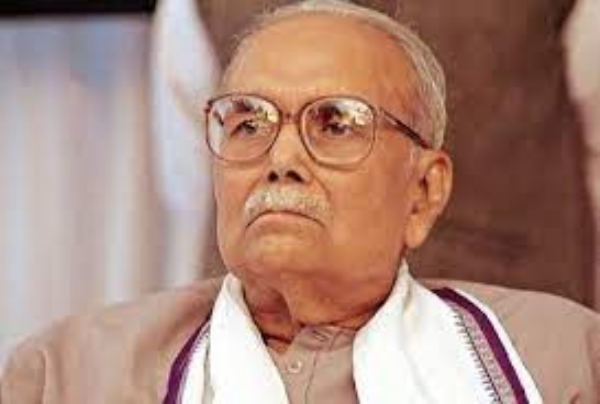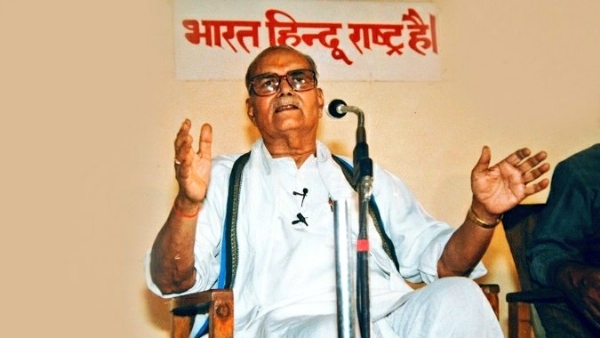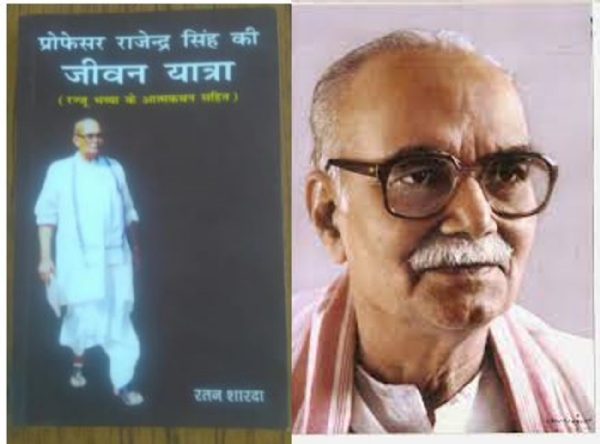Remembering Prof Rajendra Singh – Rajju Bhaiyya, The Fourth Sarsanghchaalak of RSS
30 Jan 2022 09:39:34
“There is no miracle in it. It is possible due to surface tension. God cannot be so merciless that he would drink so much of milk while millions of children go to sleep without a drop of milk.” This was Prof Rajendra Singh, affectionately addressed as Rajju bhaiyya (elder brother) explaining the phenomenon of Bhagwan Ganesh’s murtis drinking milk on 21 September 1995 when the news had spread like wild fire and Hindus across the globe had lined up at temples to offer milk to him. Rajju bhaiyya was the Sarsanghchaalak (Chief) of Rashtriya Swayamsevak Sangh (RSS) at that time that is still being accused of spreading this superstitious message!

The Scientist Bharat Did Not Have
Today, we are celebrating the birth centenary year of a great scientist and teacher who could have been a top-ranking scientist of Bharat, had he not decided to dedicate his entire life to service of society through RSS. Great Nobel laureate C V Raman had remarked that he had not seen such a clear-headed practical boy in his life. This ‘’boy’’ Rajendra Singh had scored 100 out of 100 in MSc final practical exams, for which is examiner was Sri C V Raman himself, and had stood second in MSc. Prof Raman had invited him to join him in Bengaluru but he had declined politely saying that he had decided to do research under his guru in Allahabad University and teach. He had become a swayamsevak quite late in life while he was studying his BSc and had come out of 1942 Quite India movement as a disillusioned young man. But he had imbibed enough of RSS values that he knew what he was going to do with his future.
The Teacher And The Student
Rajju bhaiyya’s first love was teaching and learning. He had joined as a and became one lecturer at a very young age and became a Professor at the age of 24, the youngest professors for sheer love and dedication he had for Physics and his students. He would visit hostels to teach students. He would sit with his students to explain to them the complex physics topics in Hindi and also teach them English so they could score well. His compassion for his students was such that when someone gifted him a shirt or kurta, he would suggest that that it could be given to their lesser fortunate brother students as they needed it more and that they needed to be sensitive to their needs. He would spend out of his pockets to support them. This is how he got his affectionate name, “Rajju bhaiyya’.
He loved cricket and lawn tennis. He could explain the complexity of Ilie Nastase’s excellent serves with Bernoulli’s principle.
He was ready to learn till his last days of his life. He had seen earlier Sarsanghchaalak Shri Balasaheb Deoras reciting shlokas and quotes in Sanskrit that could explain wonderful ideas pithily. He wished to learn Sanskrit and become proficient in it so he could recite with better understanding. He would carry Sanskrit Chandamama magazine for children his prachaarak jhola for which he had paid annual subscription. Later in life when he went to Kerala for ayurvedic treatment, he requested Sanskrit Bharati team to provide him tuition. It was a great sight to see him, the RSS chief, Shri H V Sheshadri (Sarkaryavaah), many other seniors and young ones attending Sanskrit classes during that month long stay.
His dedication to students was such that he would reach the university directly from station in his customary dhoti kurta or sometimes even RSS half pant so no lecture was delayed or missed. He always explained Hindu dharma and history from scientific perspective in his lectures. He would prepare his notes in train, sometimes at night. His passion for education made him one of the promoters of Saraswati Shishu Mandir along with Nanaji Deshmukh and Bhaurao Deoras.

The Conscientious Keeper Of Ethics In Public Life
He had joined RSS at the age of 20, taught for 24 years, and took voluntary retirement at the age of 44 years only. He had become a full time RSS worker at the age of 24 itself. But he would spend on all his activities from his own pocket. Even after retirement, he would use his own savings for Sangh work. Rajju bhaiyya would support various sewa projects, giving his own cheque quietly to those organisations, reminding them that it was not from Sangh but from his own savings, thus passing a message of service to the society from one’s own resources.
He was most circumspect about use of public money and RSS Guru dakshina. Though he was big hearted, he was a miser with money, specially if it was Sangh funds. Once, he expressed his displeasure to the trustees of Keshav Srushti in Mumbai in his own affectionate calm way for possible delay in completing a school project because it had received contribution from the people. His view was that no one should raise a finger against RSS swayamsevaks for not being true to their words. This was the nature of a person who was born in a very well to do family. His father being the first Indian executive engineer in the irrigation department of Uttar Pradesh. His dedication to the nation could be seen from the fact that he donated his first salary to flood relief committee set up by Congress leader Sir Tej Bahadur Sapru.
About wasteful expenditure in various functions, his solution was simple. He said, “You should donate 10% of all the expenses you incur in a function. If you find it too high, it means you are spending in excess.”
When you dedicate your life to society, you are willing to give up anything that you can. He dedicated his home that his father had bequeathed to him to Saraswati Shishu Mandir and just kept to room for his occasional visits. He didn’t just give up his career in science, but also his hobbies. He was a violine player and a very good singer. He was also a poet who would guide others to improve their poems. Many of his poems are still sung in RSS. His most famous are –
a) Nirmanon ke paawan yug mein hum charitra nirman na bhoolein (let us not forget character building in the times of national reconstruction) and
b) Dason dishaon mein jaayen, dal baadal sa chhaa jaayen (Let us expand in all the ten directions)
The Environmentalist
This habit of saving and conserving could be seen in each action of his. He never used paper napkin. If someone asked, he would explain how many trees are uprooted for such avoidable waste. He got the roses that came to him as garlands when he was nominated as Sarsanghchaalak, into ‘gulkand’. He would always travel by third class. If someone had reserved a higher class. He could eat at station from a railway vendor so no swayamsevak was bothered to bring him food from his home and come to station for it. He is remembered by some karyakartas for sleeping on a hand cart and reaching RSS office at a little convenient time rather than waking up a karyakarta at inconvenient time. This compassion for his colleagues and the society was visible in his every action. He acceded to request of his colleagues to travel by air after he became Sarsanghchaalak rather reluctantly.
The Social Man
His most outstanding quality, apart from his phenomenal photographic memory was his ability to keep in touch with people from his school days to his latest contacts. He built bridges of communications across the world at a time when there was no internet, no WhatsApp etc. From a college time peon to a big political leader, he had same affectionate relations, whom he would remember by their names, their responsibilities and their batch. His ability to keep in touch with people proved to be of great help during Emergency when he was asked to keep in touch with bureaucracy and political leaders. He could persuade Shri G B Pant to pass a bill for Cow Protection way back in 1950s because of his personal relations and humility. Not many know about his role in keeping Chaudhary Charan Singh in the proposed Janta Party fold when he was being wooed by Indira Gandhi in the fag end of Emergency. He was the go-to-person at the centre during Ram Mandir movement. It was during his stewardship of RSS that BJP formed the first government at the centre.
Many people are not aware that he was the RSS leader who persuaded BJP to support Mayawati as the first CM of Uttar Pradesh. He explained to them that it would be an exemplary step for ‘samajik samarasta’ that is social harmony to have a Dalit lady as the first CM in Bharat. He told them that she may not understand BJP at that stage but she may understand them better after interactions. Even if she didn’t it would be a great step for social harmony.
The Family Man
He invited every member of his family to his native village Banauli when he realised that he may not live much long. He used to visit his native village routinely. He was very popular with the children of his extended family. His solution or being connected to the roots was to visit one’s native place with family regularly. He also suggested that one should wear traditional dresses in social and family functions if one can’t wear them regularly due to one’s work.
He was so friendly with everyone around that he even made friends with diseases. When he came to know about his diabetes, he smiled and said, “Now I have a friend for life.” In his old age he had many ailments, but he never complained, nor did anyone see him unhappy. He had reached that stage of equanimity. This synthesis of gyan and adhyatma had created an effulgent personality that had an easy smile that offered solace to the person in front without a word.

The Calm But Assertive Hindu
During a BBC interview while he was in UK, when asked if RSS was a aggressive Hindu organisations, his answer was, “We are not aggressive, we are assertive Hindus.” When someone asked is RSS a social organisation, he responded, “RSS is a family organisation.” He believed, “Every person is good at heart. He/she may behave differently due to circumstances. One should not be angry. It solves no problem.”
His openness to various ideas can be seen from the recollection of a scientist of Indian origin. He told Rajju bhaiyya that in Bharat, we have divorced education from spirituality. Unless the two were brought together, we won’t see truly Bharatiya progress. Rajju bhaiyya smiled and said, “You wish to see a second Vivekananda. Who knows, he may come from the West this time.”
One article won’t be enough to do justice to this great personality. That is why I ended up writing his biography. He will remain a guiding light to thousands of swayamsevaks, his students and the families who had the fortune to be touched by his magic personality.
Biography of Prof. Rajendra Singh (Rajju Bhaiyya), written by Ratan Sharda Ji can be purchased from HinduEShop
